Raden Wijaya
 In
February 1292 the Mongol emperor of China,
Kublai Khan, ordered the preparation of a
punitive naval expedition directed against
Java. It was partly an act of retaliation
for King Kertanagara's refusal to pay tribute
to China, and especially for the cruel and
contemptuous way in which the Javanese ruler
had disfigured the face of an imperial envoy.
In
February 1292 the Mongol emperor of China,
Kublai Khan, ordered the preparation of a
punitive naval expedition directed against
Java. It was partly an act of retaliation
for King Kertanagara's refusal to pay tribute
to China, and especially for the cruel and
contemptuous way in which the Javanese ruler
had disfigured the face of an imperial envoy.
The fleet,
which is reported to have consisted of 1000
ships, manned with 20,000 soldiers, was ready
to leave by November. The journey was hazardous
and beset with ill- fortune. Almost immediately
after departure the convoy was hit by a typhoon;
it was refused entry into Champa, where the
loading of fresh supplies had been anticipated,
and consequently by the time it approached
the harbour at Tuban on Java's north coast
the force was already demoralized, many of
the soldiers suffering from starvation and
dysentery.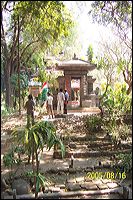

The Chinese
army was greeted by representatives from the
new settlement at Majapahit, who explained
that Kertanagara had been defeated and killed
a few months previously and that his throne
had been seized by a usurper, Jayakatwang of
Kediri. The rightful heir, Raden Wijaya, son-in-law
of Kertanagara, had established a stronghold
at Majapahit and was asking for assistance
in the annihilation of their common enemy,
in return for official tribute.
An alliance
was formed and on 15 March 1293 the combined
force launched an attack on Daha (Kediri).
The final assault on the capital was made five
days later, resulting in the loss of 5000 Kediri
lives and the surrender of Jayakatwang. Raden
Wijaya then returned to Majapahit, ostensibly
to prepare his tribute settlement, leaving
his allies to celebrate their victory. Quickly
mobilizing his forces again, however, he turned
on the Chinese army in a surprise attack, killing
many and sending the rest running back to their
ships. In this way Raden Wijaya established
the kingdom of Majapahit. Seven months later,
in November 1293, he was officially enthroned,
bearing the royal title Kertarajasa Jayawardhana.
Bhinneka Tunggal Ika
 The
national emblem of the Republic of Indonesia,
GARUDA PANCASILA, is emblazoned with the
words BHINNEKA TUNGGAL IKA. Translated,
they mean 'Unity in Diversity' or, 'We
are of many kinds, but we are one'. This
motto is a founding principle of the modern
Indonesian nation, which declares the essential
unity of its members despite ethnic, regional,
social or religious differences.
The
national emblem of the Republic of Indonesia,
GARUDA PANCASILA, is emblazoned with the
words BHINNEKA TUNGGAL IKA. Translated,
they mean 'Unity in Diversity' or, 'We
are of many kinds, but we are one'. This
motto is a founding principle of the modern
Indonesian nation, which declares the essential
unity of its members despite ethnic, regional,
social or religious differences.
The concept of BHINNEKA TUNGGAL IKA is not
new to Indonesian history. It can be traced
back to the time of the construction of Borobudur,
when the Sailendra dynasty ruled on the plains
of Central Java in the eighth and ninth centuries.
Two hundred years later, in the Brantas Valley
in East Java, King Airlangga built a united
kingdom based on this same principle.
It was, however, the 14th century poet sage
of Majapahit, Mpu Tantular, who is said to
have committed the phrase to writing for
the first time. In his religious poem Sutasoma,
composed during the reign of King Rajasanagara
(Hayam Wuruk), Mpu Tantular expounded a doctrine
of reconciliation between the Hindu and Buddhist
faiths. Such a spirit of religious tolerance
was an essential element in the foundation
and security of the newly emerging State
of Majapahit, which reached the height of
its power and influence under the guiding
hand of the prime minister Gajah Mada.
In more recent years, the words of Mpu Tantular
were an inspiration to the founders of the
first Independent Government of the Republic
of Indonesia, and today they are found immortalized
on the national emblem.
Mpu Sindok
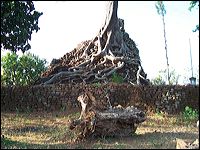 Following
the shift of political power from central
to eastern Java at the beginning of the
10th century, the first kingdom to emerge
was called Isana, established by Mpu Sindok
in A.D. 929. The capital, at Watugaluh,
is thought to have been located on the
banks of the Brantas river, in the region
of Jombang.
Following
the shift of political power from central
to eastern Java at the beginning of the
10th century, the first kingdom to emerge
was called Isana, established by Mpu Sindok
in A.D. 929. The capital, at Watugaluh,
is thought to have been located on the
banks of the Brantas river, in the region
of Jombang.
Sindok is reported to have had two wives,
one of whom, Sri Parameswari Dyah Kbi, may
have been the daughter of Dyah Wawa, the
last known ruler of ancient Mataram in Central
Java. Since it is known that Sindok had formerly
held a high ministerial position in the Mataram
government, it seems likely that he was recognized
as the successor to Dyah Wawa on the strength
of this marriage.
Despite the discovery of quite a number
of stone inscriptions dating from Sindok's
reign, the information which they reveal
has not helped to shed very much light on
this historical period. Our most informative
source, in fact, dates from the following
century, when East Java was ruled by King
Airlangga. An inscription known as the 'Calcutta
Stone', so named because it is preserved
in the Indian Museum of Calcutta, traces
the genealogy of Airlangga back to King Sindok.
Thus we are informed that, following Sindok's
death in A.D.947/8, the throne was taken
over by his daughter, Sri Isana Tunggawijaya,
who was married to a Sri Lokapala. Their
son and successor, Sri Makutawangsawardhana,
was known as the 'Sun of the Isana Dynasty'.
It was from the union of his daughter, Mahendradatta,
with the Balinese ruler Udayana, that Airlangga
was born.
Airlangga
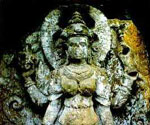 The
famous 'Calcutta Stone', dating from A.D. 1041,
describes a terrible calamity which befell
the East Javanese kingdom of Isana in the early
years of the 11th century. A rebellion incited
by a jealous vassal king resulted in the destruction
of the capital of Watugaluh. The reigning king,
Dharmawangsa, successor to Sri Makutawangsawardhana,
was murdered along with his entire family.
Only the young Airlangga, who was aged about
16 at the time, managed to escape unharmed.
The
famous 'Calcutta Stone', dating from A.D. 1041,
describes a terrible calamity which befell
the East Javanese kingdom of Isana in the early
years of the 11th century. A rebellion incited
by a jealous vassal king resulted in the destruction
of the capital of Watugaluh. The reigning king,
Dharmawangsa, successor to Sri Makutawangsawardhana,
was murdered along with his entire family.
Only the young Airlangga, who was aged about
16 at the time, managed to escape unharmed.
After spending three or four years in the safety
of a forest retreat, Airlangga, as the closest
surviving relative to Dharmawangsa, emerged to
take over the throne in about 1020. The early
part of his reign was spent putting down rebellions
and securing the borders of his kingdom. Among
his successful military campaigns were those
against King Wishnuprabhawa of Wuratan, King
Wijaya of Wengker, as well as the subjugation
of a powerful queen in the south. In 1032 Airlangga
attacked and defeated the ruler of Wurawari,
who is believed to have been responsible for
the earlier destruction of the old capital of
Isana.By the end of Airlangga's reign, in the
mid 11th century, the kingdom which he had established
is believed to have stretched from Pasuruan in
the east, to present day Madiun in the west.
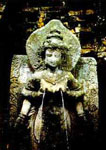 Although
there are few surviving archaeological remains
dating from his time, Airlangga is known to have
been a keen patron of the arts, notably literature.
In around 1035, the court poet Mpu Kanwa produced
the Arjuna Wiwaha, which has to this day remained
one of Java's most popular classical stories.
Adapted from the Indian Mahabharata epic, the
poem recounts episodes in the life of the hero
sage Arjuna, who was an incarnation of the Hindu
god Wishnu. There are reasons to believe that
the poem was a portrait of the life of Airlangga
himself. He, like Arjuna, was seen as a divine
incarnation, apparently laid to rest at Candi
Belahan, where he was portrayed in stone as Wishnu
on Garuda.
Although
there are few surviving archaeological remains
dating from his time, Airlangga is known to have
been a keen patron of the arts, notably literature.
In around 1035, the court poet Mpu Kanwa produced
the Arjuna Wiwaha, which has to this day remained
one of Java's most popular classical stories.
Adapted from the Indian Mahabharata epic, the
poem recounts episodes in the life of the hero
sage Arjuna, who was an incarnation of the Hindu
god Wishnu. There are reasons to believe that
the poem was a portrait of the life of Airlangga
himself. He, like Arjuna, was seen as a divine
incarnation, apparently laid to rest at Candi
Belahan, where he was portrayed in stone as Wishnu
on Garuda.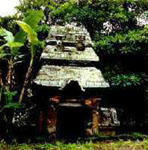 Towards
the end of his life, Airlangga was faced with
the problem of succession. The rightful heir,
the princess Sanggramawijaya, refused the throne,
preferring to live her life as a hermit. She
is traditionally associated with the legend of
Dewi Kilisuci and the cave of Selomangleng at
Kediri.
Towards
the end of his life, Airlangga was faced with
the problem of succession. The rightful heir,
the princess Sanggramawijaya, refused the throne,
preferring to live her life as a hermit. She
is traditionally associated with the legend of
Dewi Kilisuci and the cave of Selomangleng at
Kediri.Airlangga's realm was, as a result, eventually divided between two of his sons, giving rise to the separate kingdoms of Janggala and Kediri. It was Kediri, however, which was to become the dominant power until the rise of Singosari in the early 13th century.
Rajasa Dynasty
 The
rulers of Singosari and Majapahit trace their
origins back to the mysterious figure of Ken
Angrok, who founded the Rajasa dynasty early
in the 13th century. According to the Pararaton
1), our main source of literary information
about this period, Ken Angrok was born in the
Malang region, apparently from the union of
his mother, Ken Endok, with the god Brahma
2). Abandoned in a cemetery shortly after his
birth, the infant was subsequently adopted
by a thief named Lembong, whose questionable
talents the child was later to inherit.
The
rulers of Singosari and Majapahit trace their
origins back to the mysterious figure of Ken
Angrok, who founded the Rajasa dynasty early
in the 13th century. According to the Pararaton
1), our main source of literary information
about this period, Ken Angrok was born in the
Malang region, apparently from the union of
his mother, Ken Endok, with the god Brahma
2). Abandoned in a cemetery shortly after his
birth, the infant was subsequently adopted
by a thief named Lembong, whose questionable
talents the child was later to inherit.
As a young man, Ken Angrok became a notorious
gambler, running up debts to the point where
both his mother and .stepfather were forced into
slavery. Such reckless behaviour earned him a
great deal of unpopularity in the community,
and on more than one occasion Brahma himself
had to intervene when he feared for his son's
life. Yet, Ken Angrok was destined to become
a great king. Signs which indicated him as an
incarnation of the god Wishnu were revealed to
the Brahmin priest Dang Hyang Lohgawe, who travelled
from India in search of the youth. He found him
at a gambling table in the village of Taloka.
Following the advice of the priest, Ken Angrok
accompanied him to Tumapel, where he was placed
in the employment of the local ruler, Tunggul
Ametung.
Tunggul Ametung had a beautiful young wife named
Ken Dedes, the daughter of Mpu Purwa, a renowned
Buddhist priest. She had been abducted by the
Tumapel ruler while her father was away practicing
asceticism in the forest. Returning to find his
daughter gone, Mpu Purwa had laid a curse on
Tunggul Ametung, swearing that he would meet
his end by being stabbed to death by a keris
(Javanese double edged dagger). Ken Dedes, on
the other hand, was promised a life of happiness
and furfilment.
As the gods had willed, Ken Angrok happened
to be in the park of Baboji on the day when the
ruler of Tumapel and his wife, who was three
months pregnant, were passing by. The carriage
came to a halt, and as Ken Dedes descended a
gentle breeze caused her skirts to part momentarily,
allowing the youth a glimpse of the light radiating
from between her thighs. Reporting his experience
to the priest Lohgawe, Ken Angrok was advised
that a woman who displayed such signs possessed
enormous power, and whoever took her to wife,
regardless of his character or position, would
inevitably become a king of kings. On hearing
the words of the priest, Ken Angrok resolved
to win the hand of Ken Dedes, even if it meant
having to kill her husband.
In the village of Lulumbang there lived a renowned
metal smith named Mpu Gandring who, it was said,
could forge a kens capable of overcoming the
strongest magical protection. Since it was known
that Tunggul Ametung was a man of great power,
a special weapon had to be created in order to
destroy him. On hearing Ken Angrok's request,
therefore, Mpu Gandring said that he would need
a full year in which to perfect the blade. Knowing
that Ken Dedes was pregnant, and determined to
murder Tunggul Ametung before his wife gave birth
to a possible son and heir, Ken Angrok found
these conditions unacceptable. Impatiently, he
demanded that Mpu Gandring complete the job in
five months, and then went on his way.
Joko Dolog
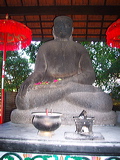 A
stone image of the Buddha Akshobya, curiously
matching the description of the 'missing statue'
at Candi Jawi, can be found today in a small,
secluded park in Surabaya. Known locally as
Joko Dolog, the statue displays a lengthy sanskrit
inscription, carved neatly around its base.
When it was translated for the first time early
in this century, the inscription was found
to reveal important historical information
dating from the period immediately prior to
the founding of Majapahit. Executed in the
year 1289 by a Buddhist scribe named Nada,
the contents are roughly as follows:
A
stone image of the Buddha Akshobya, curiously
matching the description of the 'missing statue'
at Candi Jawi, can be found today in a small,
secluded park in Surabaya. Known locally as
Joko Dolog, the statue displays a lengthy sanskrit
inscription, carved neatly around its base.
When it was translated for the first time early
in this century, the inscription was found
to reveal important historical information
dating from the period immediately prior to
the founding of Majapahit. Executed in the
year 1289 by a Buddhist scribe named Nada,
the contents are roughly as follows:
It is said that in times long past the sage
Mpu Bharada divided the land of Java into the
kingdoms of Janggala and Panjalu (Kediri), with
the purpose of settling a dispute between two
brothers over the right to royal succession.
The division was created magically, by means
of holy water sprinkled out of a jar from the
sky. Since the reign of Sri Wishnuwardhana, however,
the country had been re-united, to the joy and
benefit of all. The present ruler, of whom the
statue was said to have been a portrait, was
Wishnuwardhana's son, Kertanagara, who had commissioned
the image as a symbol of this re-unification.
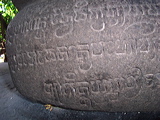 The information contained in the Joko Dolog
inscription is especially interesting because
it appears to establish the authenticity of certain
historical figures and events, previously known
only from ancient Javanese literature. The story
of the division of Java by the sage Mpu Bharada
is of course well known, and refers to the reign
of King Airlangga in the 11th century. On the
other hand, by giving Wishnuwardhana the credit
for having re-united the country, the inscription
has tended to cast doubt upon the reliability
of traditional literary sources, particularly
with regard to the story of Ken Angrok and Ken
Dedes, which has by some been dismissed as a
complete fabrication.
The information contained in the Joko Dolog
inscription is especially interesting because
it appears to establish the authenticity of certain
historical figures and events, previously known
only from ancient Javanese literature. The story
of the division of Java by the sage Mpu Bharada
is of course well known, and refers to the reign
of King Airlangga in the 11th century. On the
other hand, by giving Wishnuwardhana the credit
for having re-united the country, the inscription
has tended to cast doubt upon the reliability
of traditional literary sources, particularly
with regard to the story of Ken Angrok and Ken
Dedes, which has by some been dismissed as a
complete fabrication.
Yet, since the discovery in 1975 of a number
of inscribed copper sheets originating from the
region of Kediri, new light has been shed on
the early years of the Singosari period. Known
as the inscription of Mula Malurung, issued by
King Kertanagara in 1255, it mentions the names
of Wishnuwardhana, Tohjaya, as well as a number
of other kings whose names have been hitherto
unknown to historians. Finally, and most interesting,
the Mula Malurung inscription appears to suggest
the existence of Ken Angrok, thus at least confirming
an historical basis for a story which was beginning
to fade entirely into the realm of myth.
Kertanagara
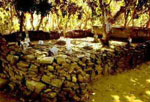 The
last and most well known of the Singosari
kings was Kertanagara. Praised in the Nagarakertagama as
a devout Buddhist, well versed in many branches
of philosophy and esoteric science, he is
considered to have been the first Javanese
ruler to envision a united Indonesia. Kertanagara's
dreams, however, were not to be fully realized
until half a century after his death, during
the reign of King Hayam Wuruk of Majapahit.
The expansionist foreign policy which he
pursued, partly as a response to the increasing
threat posed by the Mongol emperor, Kublai
Khan, was perhaps too ambitious. His expedition
to Bali in 1284 was inconclusive, while the
army which he sent to subjugate the kingdom
of Malayu in lower Sumatra left him unable
to cope with rebellion closer to home. Kertanagara
had, further, lost the favour of a number
of powerful and influential statesmen, who
had been loyal to his father, Wishnuwardhana.
Two of these especially, the former prime
minister Mpu Raganata and the security advisor
Aria Wiraraja, had been relegated to lower
positions in the new government.
The
last and most well known of the Singosari
kings was Kertanagara. Praised in the Nagarakertagama as
a devout Buddhist, well versed in many branches
of philosophy and esoteric science, he is
considered to have been the first Javanese
ruler to envision a united Indonesia. Kertanagara's
dreams, however, were not to be fully realized
until half a century after his death, during
the reign of King Hayam Wuruk of Majapahit.
The expansionist foreign policy which he
pursued, partly as a response to the increasing
threat posed by the Mongol emperor, Kublai
Khan, was perhaps too ambitious. His expedition
to Bali in 1284 was inconclusive, while the
army which he sent to subjugate the kingdom
of Malayu in lower Sumatra left him unable
to cope with rebellion closer to home. Kertanagara
had, further, lost the favour of a number
of powerful and influential statesmen, who
had been loyal to his father, Wishnuwardhana.
Two of these especially, the former prime
minister Mpu Raganata and the security advisor
Aria Wiraraja, had been relegated to lower
positions in the new government.
According
to one historical account, the Kidung Panji
Wijayakrama, the rebellion which led to
Kertanagara's death in 1292 was, in part, incited
by Wiraraja, who had been given a relatively
minor position as governor of Sumenep in Madura.
From information
contained in the inscription of Mula Malurung,
we learn that Kertanagara, as crown prince
and heir apparent to the throne of Singosari,
had already been installed as ruler of Kediri
in 1254, fourteen years before his father's
death. This event was unlikely to have pleased
his brother-in-law, Jayakatwang, who claimed
direct descent from the old kings of Kediri,
and who was thus looking for an opportunity
for revenge. The moment came in 1292. Despite
repeated warnings from his ministers, Kertanagara
did not recognize the weakness of his position.
The result was that he died defending his palace,
together with many of his closest followers,
heavily outnumbered by the forces of Jayakatwang.
The story of the gallant but hopeless defense
put up by his son-in-law, Raden Wijaya, has
been preserved in detail in the famous Kudadu
inscription, discovered on the slopes of Mt
Butak, to the south of Mojokerto. The inscription
relates how the two commanders, Raden Wijaya
and Ardaraja, had been given the task of defending
the area north of the Singosari capital. Ardaraja,
however, who was a son of Jayakatwang, is said
to have betrayed his comrade and, perhaps on
account of divided loyalty, gone over to the
enemy. Reduced finally to an exhausted force
of just twelve men, Raden Wijaya fled across
the Strait of Madura and took refuge with Aria
Wiraraja in Sumenep. From there he designed
his strategy to return to the mainland.
The role
played by Aria Wiraraja in the fall of Singosari
and the birth of Majapahit has not yet been
fully understood. On the one hand he is said
to have influenced Jayakatwang to rebel against
Kertanagara; yet he also sheltered Raden Wijaya
and offered advice on how the young exile could
establish a new kingdom. Raden Wijaya was not
long in acting. He returned to Kediri, where
he offered his allegiance to Jayakatwang, in
return for a small area of forest land at Tarik,
near Mojokerto. Here, together with a band
of loyal Madurese followers, he founded the
new settlement of Majapahit.
Shiwa - Buddha
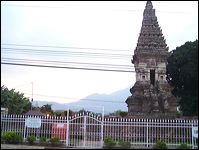 In
the year A.D. 1359, on his return from an extended
tour of the eastern provinces, King Hayam Wuruk
of Majapahit stopped off at the temple of Jajawa
(Candi
Jawi) at Pandaan, in the foothills of
Mt Welirang. His purpose was to place offerings
at the shrine of his great-grandfather Kertanagara,
last king of Singosari, in whose memory the
temple had been built. The Nagarakertagama
describes in detail the magnificence of the
sacred compound. The principal monument, in
particular, was unique in that it was a Shiwaite
sanctuary crowned with a Buddhist ornament.
It thus reflected clearly the advanced religious
philosophy expounded by Kertanagara, who is
said to have returned, on his death, to the
realm of 'ShiwaBuddha'. The shrine further
contained two mortuary statues of the king,
representing the essence of both religions.
Yet, as Prapanca explains in his poem, the
image of the Buddha Akshobya had mysteriously
disappeared at a time when the monument had
been struck by lightning, in 1331. While regretting
that the statue had vanished, it was accepted
as a sign of the Buddha's supreme manifestation,
i.e. that of Non-Being!
In
the year A.D. 1359, on his return from an extended
tour of the eastern provinces, King Hayam Wuruk
of Majapahit stopped off at the temple of Jajawa
(Candi
Jawi) at Pandaan, in the foothills of
Mt Welirang. His purpose was to place offerings
at the shrine of his great-grandfather Kertanagara,
last king of Singosari, in whose memory the
temple had been built. The Nagarakertagama
describes in detail the magnificence of the
sacred compound. The principal monument, in
particular, was unique in that it was a Shiwaite
sanctuary crowned with a Buddhist ornament.
It thus reflected clearly the advanced religious
philosophy expounded by Kertanagara, who is
said to have returned, on his death, to the
realm of 'ShiwaBuddha'. The shrine further
contained two mortuary statues of the king,
representing the essence of both religions.
Yet, as Prapanca explains in his poem, the
image of the Buddha Akshobya had mysteriously
disappeared at a time when the monument had
been struck by lightning, in 1331. While regretting
that the statue had vanished, it was accepted
as a sign of the Buddha's supreme manifestation,
i.e. that of Non-Being!Gajah Mada
 According
to the Nagarakertagama, and supported by inscriptions
dating from the late 13th and early 14th centuries,
Raden Wijaya Sri Kertarajasa Jayawardhana married
the four daughters of Kertanagara. From his
eldest and principal queen, Dyah Dewi Tribhuwaneshwari,
was born a son, Jayanagara, who succeeded to
the throne on his father's death in 1309.
According
to the Nagarakertagama, and supported by inscriptions
dating from the late 13th and early 14th centuries,
Raden Wijaya Sri Kertarajasa Jayawardhana married
the four daughters of Kertanagara. From his
eldest and principal queen, Dyah Dewi Tribhuwaneshwari,
was born a son, Jayanagara, who succeeded to
the throne on his father's death in 1309.
During the reigns of both Kertarajasa and Jayanagara
the focus was on the establishment of stability
within the new state. Numerous uprisings occurred,
all of which were put down successfully, though
not without cost of lives. Then, in 1328, Jayanagara
was assassinated. It is said that he was overprotective
towards his two half sisters, born from Kertarajasa's
youngest queen, Dyah Dewi Gayatri. Complaints
lodged by the two young princesses led to the
intervention of Gajah Mada, the talented minister
who was later to take Majapahit to the height
of its glory. He arranged for a surgeon to murder
the king while pretending to perform an operation
With the death of Jayanagara the throne of Majapahit
was without a direct male heir. The position
was occupied instead by the eldest of the deceased
king's two sisters, Tribhuwana Wijayatungga Dewi,
who ruled until 1350. By that time her son, Hayam
Wuruk, who had been born in 1334, became old
enough to take over. During his reign, as well
as that of his mother, effective power was in
the hands of Gajah Mada, who had been appointed
prime minister and commander-in chief.
Gajah Mada stands among the greatest of Indonesia's
heroes. From the time when he swore his famous
oath of allegiance, the Sumpah Palapa, until
his death in 1364, a period of just 28 years,
he succeeded in spreading the power and influence
of Majapahit throughout the archipelago, and
even beyond the boundaries of the present day
Republic of Indonesia.
The
waterfall Madakaripura, to the south
of Probolinggo, is believed to have
been a part of an area of land granted
to Gajah Mada by Hayam Wuruk. According
to tradition, it was here that Gajah
Mada formulated his famous oath of
allegiance, the Sumpah Palapa, in
which be vowed to unite the Indonesian
archipelago.
| |
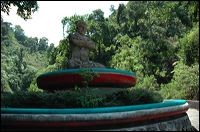

Tidak ada komentar:
Posting Komentar